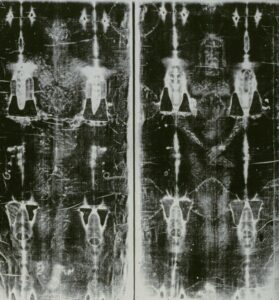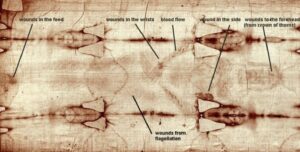This article, published on August 6, 2022, is an addition to the UBtheNEWS: Shroud of Turin Report. Think of it as a conversation starter, a place holder. It led to a wonderful conversation with Barrie Schwortz, the STURP photographer, which pointed me in the direction of additional research, of course. Already, this had led to some new questions and new images (artistic renderings) from five hundred years ago.
For instance, from a theistic perspective, consider that the first social events involving display of the Shroud occurred with people who knew nothing about photographic negatives. The “reverse light image” phenomenon was not a part of their world. Did God confuse his children with a scientifically inexplainable and backwards image or did God’s children confuse themselves, once they learned about photographic negatives and then applied an anthropomorphic perspective to the evidence? That is the question.
Summary
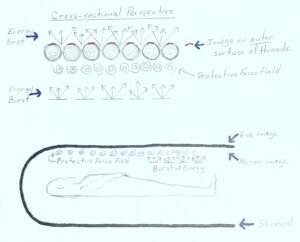 The faithful have faith-based questions (and opinions) about Jesus’ death. One question is whether Jesus was pierced by a Roman centurion’s spear on the left side or right side. Another question is whether Jesus was wrapped in the Shroud of Turin.
The faithful have faith-based questions (and opinions) about Jesus’ death. One question is whether Jesus was pierced by a Roman centurion’s spear on the left side or right side. Another question is whether Jesus was wrapped in the Shroud of Turin.
The New Testament records do not specify which side. But the information provided about blood and water coming out of the body somewhat suggests that it would have been the left side. The left side is also consistent with a right-handed person standing in front of someone and using their stronger arm to thrust the spear. As well, The Urantia Book says that Jesus’ body was pierced on the left side.
Christian tradition is generally aligned with the pierce being on the right side. And, a consensus exists regarding interpretations of the Shroud of Turin image, which places the wound on the right side.
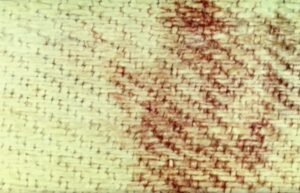 However, there is an assumption regarding the image on the Shroud of Turin. The assumption is that the image was formed on the side of the Shroud closest to the body, thus producing a mirror image. The negative-like shading of the image encourages parallels to photographic processes.
However, there is an assumption regarding the image on the Shroud of Turin. The assumption is that the image was formed on the side of the Shroud closest to the body, thus producing a mirror image. The negative-like shading of the image encourages parallels to photographic processes.
This review considers the possibility that the image formed on the outer side, thus rendering it a true image. Additionally, the “photographic negative” effect associated with the Shroud can be explained by this alternative theory. The accompanying illustrations roughly suggest ONE possibility for how this might have occurred.
As far as I know, the alternative logic presented here has never been put forth before from either a Christian or a Urantia Book perspective. After coming up with this theory, I came across a close-up photo. Notice the numerous examples that show blood around the edges of a thread on all four sides of it, created by the weave. Yet there is no or little blood on the top of the thread.
Review
Consider that if Jesus’ body was wrapped in the Shroud of Turin, then the authors of The Urantia Book would be both aware of misunderstandings and obliged to specify on which side Jesus was pierced. And this detail is provided:
(187:5.7) Because this was the preparation day for both the Passover and the Sabbath, the Jews did not want these bodies to be exposed on Golgotha. Therefore, they went before Pilate asking that the legs of these three men be broken, that they be dispatched, so that they could be taken down from their crosses and cast into the criminal burial pits before sundown. …
(187:5.8) When these soldiers arrived at Golgotha, … they found Jesus already dead, much to their surprise. However, in order to make sure of his death, one of the soldiers pierced his left side with his spear. …
The obligation to provide revelatory information derives from considerations that created a humanly unsolvable mystery. The sentimentally motivated, post resurrection request by the celestial hosts is said to have led to the dematerialization of Jesus’ body.
(189.2.1) At ten minutes past three o’clock, as the resurrected Jesus fraternized with the assembled … personalities from the seven mansion worlds …, the chief of archangels—the angels of the resurrection—approached Gabriel and asked for the mortal body of Jesus. Said the chief of the archangels: ” … [W]e would have his mortal remains put in our custody for immediate dissolution. We do not propose to employ our technique of dematerialization; we merely wish to invoke the process of accelerated time. It is enough that we have seen the Sovereign live and die on Urantia; the hosts of heaven would be spared the memory of enduring the sight of the slow decay of the human form of the Creator and Upholder of a universe. In the name of the celestial intelligences …, I ask for a mandate giving me the custody of the mortal body of Jesus of Nazareth and empowering us to proceed with its immediate dissolution.”
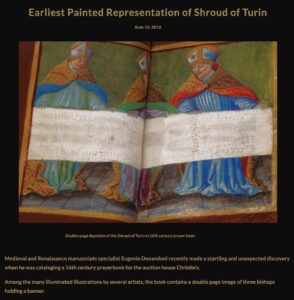 (189.2.8). The mortal remains of Jesus underwent the same natural process of elemental disintegration as characterizes all human bodies on earth except that, in point of time, this natural mode of dissolution was greatly accelerated, hastened to that point where it became well-nigh instantaneous.
(189.2.8). The mortal remains of Jesus underwent the same natural process of elemental disintegration as characterizes all human bodies on earth except that, in point of time, this natural mode of dissolution was greatly accelerated, hastened to that point where it became well-nigh instantaneous.
The sentimental interests of our celestial hosts caused a noteworthy cultural phenomenon, involving disagreements that can only be answered by revelation. Consider how providing information about the crucifixion, resurrection, and dematerialization of Jesus’ body is consistent with all the listed purposes for this epochal revelation:
(101:4.6) 1. The reduction of confusion by the authoritative elimination of error.
(101:4.7) 2. The co-ordination of known or about-to-be-known facts and observations.
(101:4.8) 3. The restoration of important bits of lost knowledge concerning epochal transactions in the distant past.
(101:4.9) 4. The supplying of information which will fill in vital missing gaps in otherwise earned knowledge.
(101:4.10) 5. Presenting cosmic data in such a manner as to illuminate the spiritual teachings contained in the accompanying revelation.
On top of the circumstances and mysteries directly related to the resurrection, Biblical passages point to this issue in the context of prophecy fulfillment.
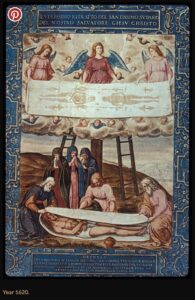 John 19 33-37: 33 But when they came to Jesus and found that he was already dead, they did not break his legs. 34 Instead, one of the soldiers pierced Jesus’ side with a spear, bringing a sudden flow of blood and water. 35 The man who saw it has given testimony, and his testimony is true. He knows that he tells the truth, and he testifies so that you also may believe. 36 These things happened so that the scripture would be fulfilled: “Not one of his bones will be broken,” 37 and, as another scripture says, “They will look on the one they have pierced.”
John 19 33-37: 33 But when they came to Jesus and found that he was already dead, they did not break his legs. 34 Instead, one of the soldiers pierced Jesus’ side with a spear, bringing a sudden flow of blood and water. 35 The man who saw it has given testimony, and his testimony is true. He knows that he tells the truth, and he testifies so that you also may believe. 36 These things happened so that the scripture would be fulfilled: “Not one of his bones will be broken,” 37 and, as another scripture says, “They will look on the one they have pierced.”
Zechariah 12:10 Then I will pour out on the house of David and on the people of Jerusalem a spirit of grace and prayer, and they will look on Me, the One they have pierced. They will mourn for Him as one mourns for an only child, and grieve bitterly for Him as one grieves for a firstborn son.
Note the emphasis John places on the testimony of the soldier. Interestingly, the word Revelator/revelator is used a total of four times in The Urantia Book. Twice it appears as “John the Revelator.”
In the context of all these various references from the Bible and The Urantia Book, now consider the idea that, if (seemingly) everyone is mistaken about whether the image is on the inner or outer side of the Shroud, then the mysteries disappear and The Urantia Book shows up consistently once again as providing accurate revelatory information.
The illustrations are an effort to broaden our thinking on this subject. Even though no one knows how the image appeared on the Shroud, nonetheless, we can notice when analysis from an anthropomorphic perspective is taking place. And it seems that this is very much at issue when it comes to analyzing mysteries related to the Shroud. Just because the unfaithful expect completely scientific explanations does not mean that the faithful should fall into the trap of an anthropomorphic mindset, when speaking amongst themselves.
Regarding the dematerialization of Jesus’ body, The Urantia Book recounts:
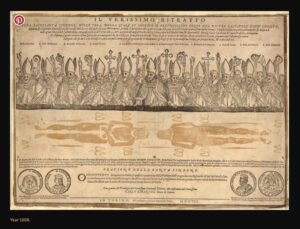 (189:2.3) After the chief of archangels had been granted this request, he summoned to his assistance many of his fellows, together with a numerous host of the representatives of all orders of celestial personalities, and then, … proceeded to take possession of Jesus’ physical body. This body of death was a purely material creation; it was physical and literal; it could not be removed from the tomb as the morontia [spirit/angelic] form of the resurrection had been able to escape the sealed sepulchre. By the aid of certain morontia auxiliary personalities, the morontia form can be made at one time as of the spirit so that it can become indifferent to ordinary matter, while at another time it can become discernible and contactable to material beings, such as the mortals of the realm.
(189:2.3) After the chief of archangels had been granted this request, he summoned to his assistance many of his fellows, together with a numerous host of the representatives of all orders of celestial personalities, and then, … proceeded to take possession of Jesus’ physical body. This body of death was a purely material creation; it was physical and literal; it could not be removed from the tomb as the morontia [spirit/angelic] form of the resurrection had been able to escape the sealed sepulchre. By the aid of certain morontia auxiliary personalities, the morontia form can be made at one time as of the spirit so that it can become indifferent to ordinary matter, while at another time it can become discernible and contactable to material beings, such as the mortals of the realm.
(189:2.4) … The larger of these two stones was a huge circular affair, much like a millstone, and it moved in a groove chiseled out of the rock, so that it could be rolled back and forth to open or close the tomb. When the watching Jewish guards and the Roman soldiers, in the dim light of the morning, saw this huge stone begin to roll away from the entrance of the tomb, apparently of its own accord—without any visible means to account for such motion—they were seized with fear and panic, and they fled in haste from the scene. The Jews fled to their homes, afterward going back to report these doings to their captain at the temple. The Romans fled to the fortress of Antonia and reported what they had seen to the centurion as soon as he arrived on duty.
(189:4.6) … By this hour there was just enough of the dawn of a new day to enable Mary to look back to the place where the Master’s body had lain and to discern that it was gone. In the recess of stone where they had laid Jesus, Mary saw only the folded napkin where his head had rested and the bandages wherewith he had been wrapped lying intact and as they had rested on the stone before the celestial hosts removed the body. The covering sheet lay at the foot of the burial niche.
From a believer’s perspective, when it comes a divine and mysterious process being involved with the creation of the Shroud image, the Christian and Urantia Book perspectives are differences without distinction. Whether the image occurred as part of the resurrection process or to spare angels from experiencing the slow decay of Jesus’ physical body, the issue is a presumption of divine intervention. And that means, literally, with God all things are possible.
Is it for the faithful to define the creative options and limitations of God!?! Of course not. The real challenge for both groups is to avoid the temptation to think in overly materialistic (anthropomorphic) ways. Tendencies towards anthropomorphic reasoning must not be allowed to win the day.
The illustrations roughly sketch out one idea for how the image might have ended up on the outside of Shroud. If the body, Shroud, and napkin (Sudarium of Oviedo) can be managed away from the bandages, what else is possible?
Human beings make photocopies by utilizing the properties of a corona discharge, which requires reversing a mirror image, which parallels the photographic process. The “negative image” associated with the Shroud further tempts this line of thinking.
However, even if the Shroud image was created in connection with the super excitation of electrons in connection with the resurrection or a time-accelerated dematerialization, presumably some type of shielding had to occur between the body and the Shroud. Trying to capture energy to reproduce an image is the opposite of trying to protect an object from such energy.
Additionally, if some type of protective shielding is employed, possibly, surfaces in direct contact enjoyed somewhat less shielding than parts of the body that were further away from Shroud. This could account for a darker (negative) imaging effect.
Maybe the boundary line for needing a protective force (the outside of the Shroud), is where the image got created. Who are we to say for sure, either way?
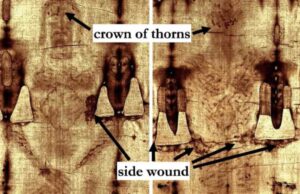
Enhanced contrast without mirroring or “negative” adjustments. Note blood traveling along the waist belt for the girdle.
The question, in this case, is more important than the answer. If there is a question, then we are free, even encouraged by circumstances, to interpret information in a manner that most naturally aligns with other existing information. There is no need to create problem just because one might be possible. Even if we cannot solve all the mysteries, we may be able, at least, to eliminate some paradoxes and apparent inconsistencies. Hopefully, this article is starting to do that for you.
With minds open to a spectrum of possibilities on a subject, a subject admittedly beyond human comprehension by the faithful, consider reasons why the tradition of it being on the right side might develop. For instance, maybe it was too awful and gruesome to think about Jesus being pierced through the heart.
Jesus had become a social phenomenon towards the end of his ministry. Would inexperienced Roman centurions be put on the job? Probably not. Would centurions in this role be sensitive to issues of mortality and gruesomeness, when making a determination about whether someone has already passed? Would the heart be an obvious insertion point for a right-handed person? This would release pericardial fluid (water) along with the blood, which accumulates from trauma and is consistent with the testimony. Piercing the heart rather than the abdomen would also minimize unpleasant odors—a practical consideration worth noting.
Notwithstanding that The Urantia Book puts its credibility on the line by asserting that its “historic facts” “will stand the on the records of the ages to come,” the community of believers, as with Christianity, find themselves sometimes passionate disagreeing about the authenticity of the Shroud and whether it foster misdirected fetishism. Obviously, the assertion about the pierce being on the left side presents the problem a bit more powerfully than what is found in Christian culture.
Along with opening Christian minds to considering a broader spectrum of possibilities regarding the authenticity of the Shroud of Turin, hopefully, this article will also do the same within the community of faithful and believing Urantia Book readers.
